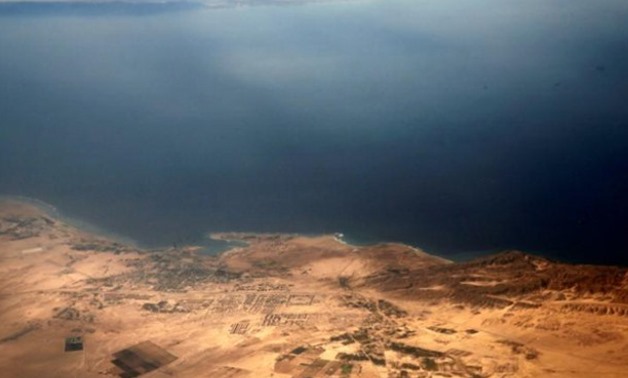
An aerial view of the coast of the Red Sea and the two islands of Tiran and Sanafir is pictured through the window of an airplane near Sharm el-Sheikh, Egypt November 1, 2016. Picture taken November 1, 2016. REUTERS/Amr Abdallah Dalsh
CAIRO – 4 March 2018: The Supreme Constitutional Court officially turned down the curtains on the Red Sea Islands Transfer Pact between Egypt and Saudi Arabia, per which Cairo announced Saudi sovereignty on the disputed islands, to put an end to a two-year judiciary battle.
The Supreme Constitutional Court, the highest court in Egypt, has finally revoked on Saturday the previous contradictory provisions issued on the Red Sea islands and, thus, stated that the implementation of the maritime border demarcation agreement between Cairo and Riyadh is “valid”.
In April 2016, both countries signed a maritime border demarcation accord, per which Egypt announced Saudi Arabian sovereignty over the strategic islands, located on the entrance of Aqaba Gulf in the Red Sea. Public outcry was sparked by hundreds of Egyptians, prompting some lawyers to take legal actions against its implementation.
The Court’s decision is “final and unchallengeable,” constitutional law expert and Professor Jamal Gebril at Helwan University told Egypt Today on Saturday. He added that the court ruling also gave the legal green-light to its implementation.
In light of the definitive ruling, Egypt Today unwinds the journey of the case before the Egyptian courts.
On March 3, 2018, the Supreme Constitutional Court revoked on Saturday the previous contradictory provisions issued on the Red Sea islands on Saturday and thus ordered the implementation of the maritime border demarcation agreement between Cairo and Riyadh.
According to the Court’s detailed judgment, the Administrative Court’s decision to annul the transfer pact was not valid since the court was not the competent authority to take up issues relating to the sovereignty of nations. The Supreme Constitutional Court invalidated the Administrative Court’s decision on the matter because the latter had no constitutional jurisdiction over administrative issues.
On June 24, 2017, President Abdel Fatah al-Sisi approves the said agreement, insisting that the matter is forever closed.
On June 21, 2017, Egypt’s Constitution Court waives the legal challenges submitted by Council Courts (the Administrative and Supreme Administrative) and the State of Commissioners, represented by the government.
On June14, 2017, Parliament approved en masse the transfer pact in a general session and referred it to President Abdel Fatah al-Sisi for ratification.
On April 10, 2017, Speaker of the Parliament, Ali Abdel Aal referred the whole matter to the Parliamentarian Committee of Constitutional and Legislative Affairs, whose members voted in majority in favor of the Saudi’s possession of the Red Sea Islands.
On January 16, 2017, Cairo’s Administrative Court accepted the challenge submitted by lawyer Khaled Ali against the Cabinet’s decision to approve the transfer pact and then declared that the Red Sea islands are Egyptian territories.
On 31 December, 2016, the Urgent Matters’ Appeal Court ordered the revocation of the Administrative Court’s June decision.
On December 29, 2016, the Cabinet approved the maritime demarcation agreement and referred it to the Parliament for ratification.
On September 29, 2016, Court of Urgent Matters overturned the Administrative Court’s decision.
On August 18, 2016, State Lawsuits Authority, which represents the government’s side, challenged the Administrative Court’s above-mentioned decision, confirming that the Red Sea islands’ transfer pact is a “sovereign matter” and that the Saudi Arabian sovereignty over the two islands is proven by several documents and was signed back in 1920 but was projected to come into force when the region becomes more stable.
On June 21, 2016, Egypt’s High Administrative Court, which addresses the legal disputes to which the state or the government is a party, annulled Egypt's maritime border demarcation agreement, confirming that the two Red Sea islands lying at the mouth of the Gulf of Aqaba are Egyptian territories.
On April 8, 2016, and during Saudi King Salman bin Abdel-Aziz's 2016 visit to Egypt, several political and economic agreements were signed, the most important of which ceded Egyptian sovereignty over the strategic islands to Saudi Arabia. Nation-wide demonstrations have later ensued.


Comments
Leave a Comment